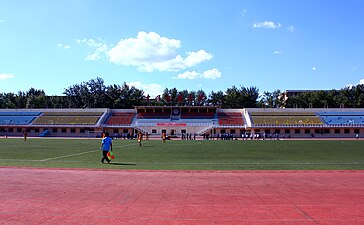
The Harbin Institute of Technology (HIT) is a public science and engineering university in Nan'gang, Harbin, Heilongjiang, China. It is now affiliated with the Ministry of Industry and Information Technology. The university is part of Project 211, Project 985, and the Double First-Class Construction.

The Beijing Institute of Technology (BIT) is a public university in Haidian, Beijing, China. It is affiliated with the Ministry of Industry and Information Technology. The university is part of Project 211, Project 985, and the Double First-Class Construction.

Chongqing University is a public university in Chongqing, China. The university is affiliated with the Ministry of Education of China, and co-funded by the Ministry of Education, the Chongqing Municipal People's Government, and SASTIND. The university is part of Project 211, Project 985, and the Double First-Class Construction.

Beihang University is a public university in Haidian, Beijing, China. It is affiliated with the Ministry of Industry and Information Technology. According to the Academic Ranking of World Universities, this university is the best university in the world in the field of aerospace engineering.

Beijing Normal University is a public university in Beijing, China. It is affiliated with the Ministry of Education of China, and co-funded by the Ministry of Education and the Beijing Municipal People's Government. The university is part of Project 211, Project 985, and the Double First-Class Construction.

Beijing Jiaotong University is a public university in Haidian, Beijing, China. It is affiliated with the Ministry of Education, and co-funded by the Ministry of Education, the Ministry of Transport, the Beijing Municipal People's Government, and China State Railway Group Company Limited. The university is part of the Double First-Class Construction and Project 211.

Beijing Forestry University is a public university located in Beijing, China. It is affiliated with the Ministry of Education, and co-sponsored by the Ministry of Education, the National Forestry and Grassland Administration, and the Beijing Municipal People's Government. The university is part of Project 211 and the Double First-Class Construction.

The University of Shanghai for Science and Technology is a municipal public university in Yangpu, Shanghai, China. The university is affiliated with the City of Shanghai and funded by the Shanghai Municipal People's Government.

The Huazhong University of Science and Technology is a public university in Wuhan, Hubei, China. It is affiliated with the Ministry of Education of China. The university is part of Project 985, Project 211, and the Double First-Class Construction.

The Wuhan University of Technology is a public university in Wuhan, Hubei, China. It is affiliated with the Ministry of Education. The university is part of the Double First-Class Construction and Project 211.

The Chengdu University of Technology is a national public research university located in Chengdu, Sichuan, China. It is a technology-focused institution co-funded by the Ministry of Education of China, the Ministry of Natural Resources of China, and the Sichuan Provincial People's Government. The university is part of the Double First-Class Construction.

The China University of Geosciences (Wuhan) is a public university in Wuhan, Hubei, China. It is affiliated with the Ministry of Education, and co-funded by the Ministry of Education and the Hubei Provincial People's Government. The university is part of the Double First-Class Construction and Project 211.

Central South University is a public university in Changsha, Hunan, China. The university is affiliated with and funded by the Ministry of Education of China. It is part of Project 211, Project 985, and the Double First-Class Construction.

Northwestern Polytechnical University is a public science and engineering university in Xi'an, Shaanxi, China. It is affiliated with the Ministry of Industry and Information Technology. The university is part of Project 211, Project 985, and the Double First-Class Construction.

The University of the Chinese Academy of Sciences is a public university headquartered in Shijingshan, Beijing, China. It is affiliated with the Chinese Academy of Sciences. The university is part of the Double First-Class Construction. Officially established in 2012, the university derives from the Graduate School of the University of Science and Technology of China founded in 1978.

Jiangnan University (江南大学) is a public university located in Wuxi, Jiangsu, China. It is affiliated with the Ministry of Education, and co-sponsored with the Jiangsu Provincial Government. The university is part of Project 211 and the Double First-Class Construction.

The Shandong University of Science and Technology is a provincial public university in Qingdao, Shandong, China. It is affiliated with the Province of Shandong and funded by the provincial government. It was established in 1951. The university offers courses in science and technology.

The China University of Petroleum (East China) is a national public university located in Qingdao, Shandong, China. It is affiliated with the Ministry of Education, and is co-sponsored by the Ministry of Education, five major state energy corporations, and the Province of Shandong. The university is part of Project 211 and the Double First-Class Construction.

The East China University of Technology is a provincial public university located in Nanchang, Jiangxi, China. It is affiliated with the Jiangxi Provincial People's Government, and co-sponsored by SASTIND, the Ministry of Natural Resources, and the China National Nuclear Corporation.
Xi'an University of Technology is a provincial public comprehensive university in Xi'an, Shaanxi, China. The university is co-sponsored by the Ministry of Industry and Information Technology and the Shaanxi Provincial Government.
































